The Internet these days seems to be buzzing with the downfall of the SHA-1 algorithm and the consequent rise of its successor, SHA-2 encryption.
As we all know, Secure Hash Algorithm (SHA) is a family of cryptographic hash functions, which was designed by United States National Security Agency (NSA) and published by National Institute of Standards & Technology (NIST). They are used popularly by the Certificate Authorities (CAs), for digitally signing the SSL certificates. The SHA family, till date, consists of SHA-0, SHA-1, SHA-2 & SHA-3 algorithms. Among all the SHA algorithms, SHA-1 is the most dominant algorithm used for encryption. Today, it accounts for most than 90% of certificates used worldwide. However, today this most popular algorithm is on its way out, making space for its successor, SHA-2 algorithm.
SHA-1 – An Aging Algorithm
So what happened to this mighty algorithm, which was, till recently basking in the glory of being the most popular algorithm used for encryption? If that had to explain in one word, the answer to that would be “Web-Security”.
SHA-1 has held that popular position close to almost two decades now. Its popularity till date explains how its performance as a security algorithm has been par excellence, so far. However, the technological advancements have caused this aging algorithm to become potentially vulnerable to attacks.
In 2005 security flaws were found in SHA-1 by the experts. As per a report by Bruce Schneir, about the calculations of Intel researcher Jess Walker, the act of SHA-1 collision attack will be highly plausible and affordable by 2018, for it to fall in the range of organized crime. It known to be highly vulnerable to Collision attacks and can be easily exploited by the attackers to create and install a fake certificate. A collision attack on any cryptographic hash finds two inputs producing the same hash value (hash collision). These attacks happen against a Certificate Authority (CA), at the time of issuing an SSL certificate.
Because of this projected vulnerability, industry-experts suggest the users to migrate from SHA-1 to a more secure option, SHA-2 algorithm. It is a set of six hash functions such as: SHA-224, SHA-256, SHA-384, SHA-512, SHA-512/224 & SHA-512/256. Users can click here to check their websites for an outdated SHA-1 algorithm.
SSL Industry and SHA-1 Deprecation
Several announcements have been made lately, to fuel up the process of migration from SHA-1 to SHA-2 encryption. Many important policies in support to deprecate the usage of SHA-1 SSL certificates have been released, which are listed below along with important dates that are to be remembered by the users:
PCI Compliance: Currently, the Payment Card Industry compliance scanners need their clients to use only the SHA-2 certificates. The PCI DSS requires the entities to use ‘strong’ cryptography, which not so subtly point toward the NIST industry standard practice of quitting SHA-1 usage and moving on to SHA-2 algorithms.
NIST Guidance: US NIST Guidance announced their decision to phase out the use of SHA-1 algorithm past January 2014 in favor of SHA-2 variants. Several agencies have quit using the SHA-1 SSL certificates across the government.
SSL Industry & Vendors: Several new policies have been announced across the SSL industry in order to inspire users to migrate to SHA-2 SSL certificates.
1. Google Chrome: Google announced its decision to display visual security indicators on sites secured with SHA-1 SSL certificates, on its upcoming versions of Chromium browsers. Based on the expiration dates and type of Chromium versions, please find the warning types and their corresponding visual cues on the Chrome browser in the following table:
| Date of Expiration | Chrome 39 (Beta Date Sept 2014) | Chrome 40 (Beta Date Nov 2014) | Chrome 41 (First Quarter—2015) |
| After 2017-01-01 | Secure with Minor Errors |
Neutral, lacking security
|
Affirmatively insecure |
| After 2016-06-01 | – – – | Secure with Minor Errors |
Neutral, lacking security |
| After 2016-01-01 | – – – | – – – |
Secure with Minor Errors |
2. Microsoft: Based on the depreciation policies for CAs released by Microsoft, here are the important dates that shall affect all the CAs who are members of Windows Root Certificate Program and are involved in issuing publicly trusted certificates:
| Date | Action |
| January 1, 2016, | CAs must stop issuing any SHA-1 SSL certificates |
| January 1, 2017, | MS Windows shall not accept any SHA-1 SSL certificates |
| January 1, 2016, | MS Windows shall not accept any SHA-1 code signing certificates without the time stamps |
Looking at the vulnerabilities presented by SHA-1 SSL certificates and the deprecation policies issued against it across the industry, it is quite apparent how advisable it is to migrate to a more secure algorithm, SHA-2 encryption for an enhanced web security with excellent encryption and browser support.






